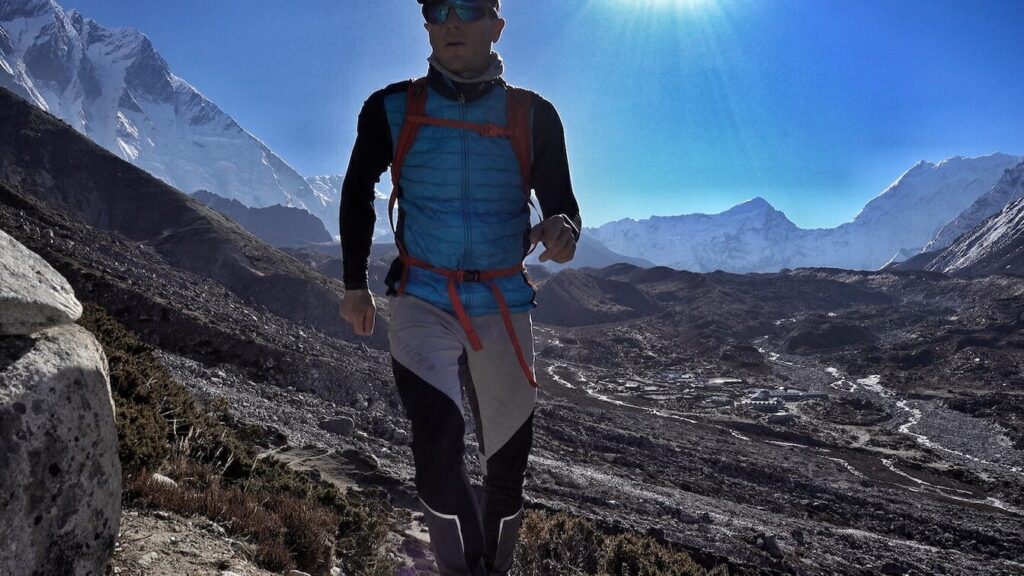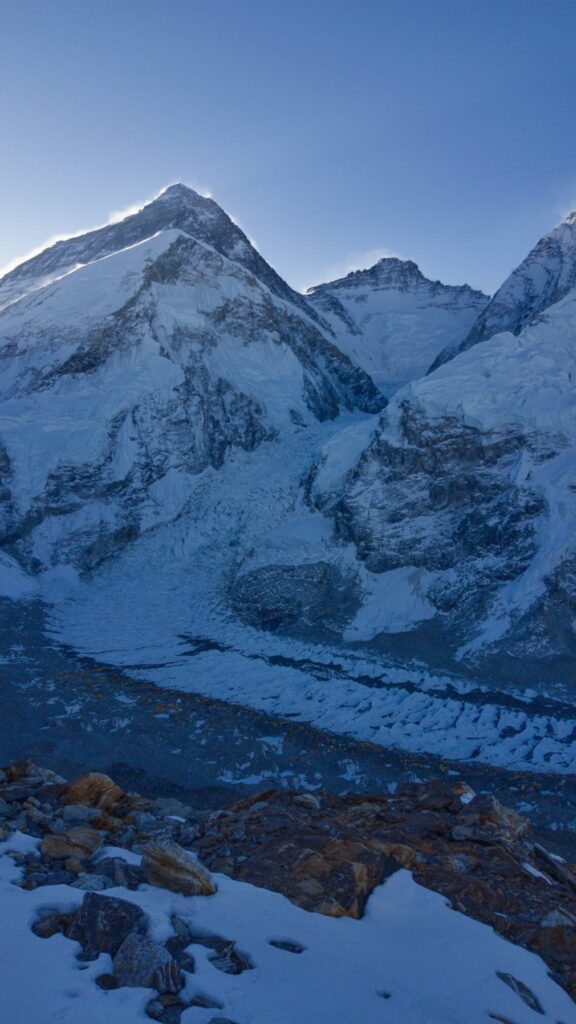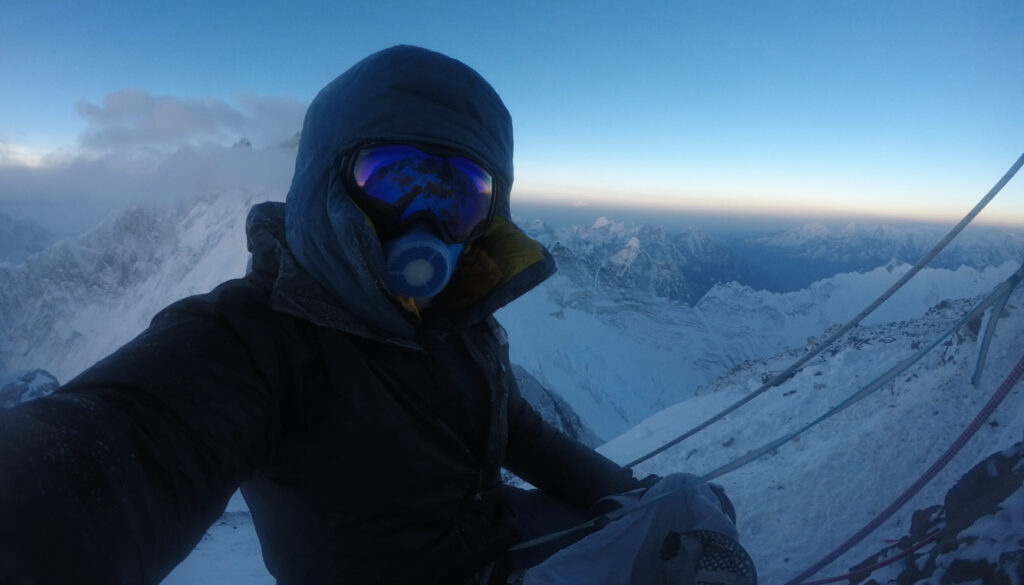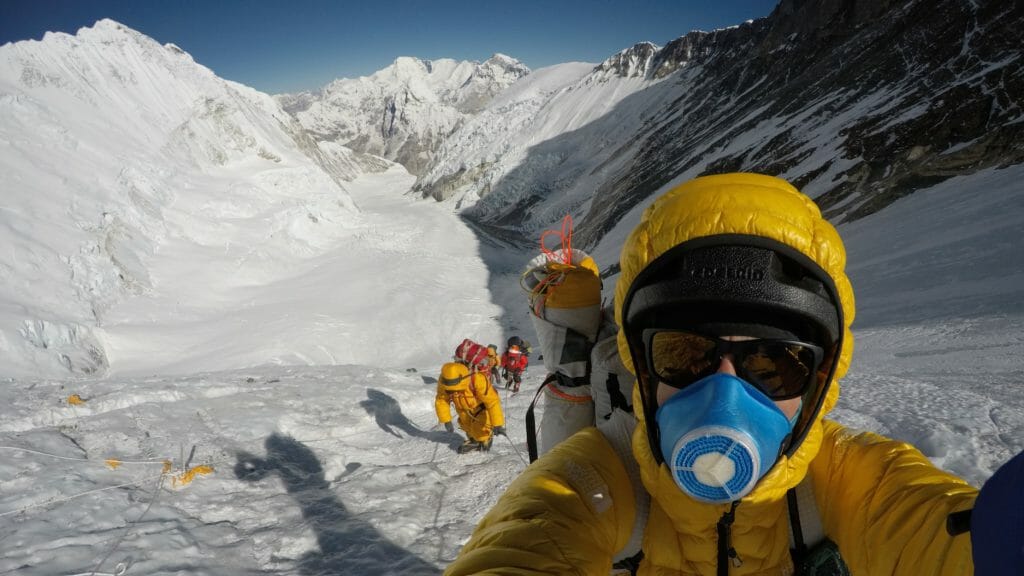In mountaineering there are no rules. Everybody can draw his or her line. My line, my style, is that I don’t use supplementary oxygen. I don’t enlist Sherpas to transport my equipment and supplies. I climb in as small a team as possible. It is in the harsh environment of high altitude—being exposed and vulnerable on a mountain—that I feel most alive.
So far I have summited five 8,000-meter peaks without oxygen: Gasherbrum II, Broad Peak, Dhaulagiri, Lhotse, and Makalu. I came very close on K2 and Shishapangma. On Shishapangma, after a 13-hour single push from the base of the south face to the top, my partner and I turned around only 5 vertical meters and 10 horizontal meters short of the summit because we deemed the avalanche danger to be too great.
In the spring of 2019, I attempted to add Mount Everest to this list. It was the next logical step. The next challenge.

From Chukhung to EBC with light equipment and in trail running mode.
Although I hoped to climb Everest without a partner and carry my own gear, I knew from the outset that a true alpine-style solo ascent wouldn’t be possible on the standard South Side route in the regular season. There are fixed lines from Everest Base Camp (EBC) to the summit and back. Each climber has no choice but to rely on the infrastructure that oxygen-and-Sherpa-supported expeditions put in place. I wouldn’t have to do a single step of trail-breaking. There would be a lot of other people.
I accepted all of these compromises to my style. With Everest, I wanted the challenge to be the altitude without added layers like a new route or a winter ascent. It would be hard enough to do it the normal way in the normal season.
Plus I still had a permit for the Nepal side. It had been extended for five years after an ice avalanche killed 16 Sherpas in the Khumbu Icefall in April 2014, prompting the early shutdown of the season. Even if I had the option to climb from the Tibet side, I’m not sure I would have taken it. I already knew the South Side from my ascent of Lhotse. Compared with the North Side, it has a lot of good points for a no-oxygen attempt.
I have been working one-on-one with Scott Johnston for four years now—consistent, structured training that has produced amazing results. Before we pivoted to Everest, Scott helped me prepare for a road marathon in early December 2018, a first for me. I almost never run on flat ground at a faster pace. After the race, where I finished in 2:58:48, I made my usual winter move to Chamonix from my home in northern Spain. When I resumed my uphill training in the Alps, I was surprised how well the marathon training translated. It ended up being a great base.
The winter conditions in Chamonix were ideal, and I was able to fit in more alpine climbing than usual. I broke up my time there with a two-week pre-acclimatization trip to the Khumbu region in Nepal, which is something I’ve done each of the past four years. At the beginning of March 2019, I traveled to Chukhung, at 4,700 meters, with Spanish ultrarunner Pablo Criado, a five-time finisher of the Tor des Geants. We played on the area’s peaks and trails and enjoyed the quieter, more relaxed rhythm of the Khumbu in early spring.
After that training block, I spent five more weeks in Chamonix. I was able to maintain my pre-acclimatization by sleeping in huts at 3,500 meters and taking the téléphérique to the Aiguille du Midi at 3,800 meters. Down low I trained strength and recovered from the time up high.
Chamonix Mountain Fit
I returned to Nepal in mid-April, ready to cash in on all this preparation.
After an initial stop in Chukhung to acclimatize on a couple trekking peaks, I moved to EBC. There I embedded with Adventure Consultants, a guiding company from New Zealand that had generously allowed me to join their team. The Nepali government requires this connection to an outfitter. Although I didn’t climb with the Adventure Consultants guides or clients on the mountain, I was on their permit and paid my fixed rope share and the liaison officer share through them. They provided a place to stay—and great company—at Base Camp.
I did three rotations prior to my summit attempt. My first took me to the base of the Lhotse Face at 7,000 meters, with one night in Camp 2 on the way up and another on the way down. The second rotation was from EBC to Camp 2 for one night, then to Camp 3 at 7,300 meters the next day. The following day I pushed up to the South Col, which is at 7,950 meters, and then dropped back to Camp 2 for another night before descending to EBC. My third and final rotation involved a one-day climb from EBC to Camp 3 and back.
Because I’ve spent most of my life moving in the mountains for long stretches of time, my fat adaptation is pretty good: for that third rotation from 5,300 meters to 7,300 meters and back, I took only six bars.
Between these rotations I dropped down to the village of Pheriche. There, at 4,200 meters, I recovered at a comfortable lodge with good food, a normal bed, and space in my room to do yoga and relax. It was a nice change of scenery.

Mount Everest with Lhotse and Nuptse, as seen from Camp 1 of Pumori (EBC and Khumbu Icefall in middle of photo).
It was also somewhat of an experiment. This was the first time I’d gone lower than base camp during an expedition—in part because it’s not always possible, but also because I’ve been concerned in the past about not getting enough time up high. Though I questioned whether touching 8,000 meters just once before my Everest summit attempt would be sufficient, this drop-back strategy ended up working really well for me. I learned that I don’t need as many nights at altitude as I once thought. Sleeping down low helps me preserve my fitness and recover from the forays up high.
Acclimatization is very much an individual puzzle. What works for one person doesn’t necessarily work for another. For Pheriche in particular, the time it takes to descend and return could outweigh the benefits of being low. Where it took me 3 hours to hike from EBC to the village and 4 hours to return to EBC, a typical Everest client could take up 8 hours from EBC to Pheriche and as much as 2 days for the return trip—a greater expenditure of energy than could be recouped through the rest and relaxation.
After recovering in Pheriche from my final rotation, I returned to EBC and planned my summit bid. I would go from Base Camp to Camp 2 and the next day from Camp 2 to Camp 4 at the South Col. From there I would aim for the top.
Everything went as planned and I arrived at the South Col on May 22, 2019.
Most people leave the South Col for the summit between 6 p.m. and 9 p.m. the evening before. I opted to start much later, at 2:30 a.m. I knew from Lhotse and Makalu that if I started too early in the night without the sun, I’d risk getting very cold.
I had the first part of the route to myself. Below 8,500 meters I encountered only three other climbers, all Sherpas. After that, the number of people coming down increased. Because I was climbing alone and without oxygen, many of these climbers questioned my sanity. “What are you doing here so late? Are you on a suicide mission? Turn around, you’re crazy!”
“No, everything is okay,” I assured these people. “I’m just trying and if I don’t feel good, I’ll go down.”
It was around 8,600 meters that I really began to feel the effects of the thin air. I concentrated on each movement, each breath. I motivated myself upward: “Okay, do the next three steps, and then we breathe. Now the next two steps.” It was more of a fight. Not in an alarming way, but I really had to focus.
When I reached a point I thought was just below the South Summit, somewhere around 8,650 meters, I saw that the entire ridge continuing above me was lined with people. They were descending very slowly, many just standing there. The knife-edge terrain makes it difficult—and dangerous—to overtake climbers or let them pass. If you have the occasional person passing, it’s no problem, but if you have a constant line of people coming toward you, you’re forced to move off the narrow track. You can’t stay clipped in to the fixed lines.
I knew immediately that it would be difficult to swim against this stream on the way up and then again on the way down. I would lose my freedom to descend, which is crucial when you’re climbing without oxygen. If for whatever reason in those last 200 meters I decided it was too dangerous to continue, I wouldn’t have been able to move quickly back to safety. I would have had trouble staying warm. It was a freedom I was reluctant to give up.
As I watched the line of climbers, the weather became colder, the wind picked up, and it started to snow. Already the number of people was a red flag; the weather conditions changing for the worse made my decision even easier. I turned around.
It didn’t take much deliberation because I had thought of all the possibilities in advance. I had prepared myself for exactly this scenario. Reaching the summit wasn’t worth the risk of getting stuck on the descent.
It took me 4 hours to get back to the South Col, then another 6 hours to reach Camp 2. That took a bit longer than it should have as I could not find my headlamp when it got dark. Two very kind Sherpas let me sneak into their headlamp light to see enough to get down to Camp 2 safely.

Below the Balcony at around 8,400 meters on my summit attempt.
I dropped to Base Camp the next day, Pheriche the day after that. I was tired and felt the effort in my legs, but I was far from destroyed. Other people remarked on how normally I was moving. They’re used to people coming down from Everest looking absolutely devastated, totally wrecked. On the mountain, only one other climber ever overtook me, and it was someone using oxygen. My training and acclimatization strategies had worked. They had paid off in a level of fitness that enabled me to handle and recover from a massive day—almost summiting Everest—in a surprisingly short amount of time.
As it turns out, I had come closer to the summit than I thought.
Back in Kathmandu on May 27, over a pizza with Adventure Consultants guide Rob Smith, I discovered that I’d made it higher on Everest than 8,650 meters. We were looking at photos and Rob clarified that I was not below the South Summit as I had originally thought, but above it. I had reached an altitude of 8,750 meters! It still wasn’t the summit, nor would I have changed my decision to turn around. Everything remains the same, except that I’m even happier with how far I got that day. A hundred meters up there means a lot.
The crowds were just one piece of the puzzle—the puzzle of getting it right and standing on top or not quite getting there. Other pieces were the weather that turned too windy and cold, and the thin, feeble air that leaves no margin for waiting or being tied to the movements of others. The situation above the South Summit didn’t surprise or frustrate me. There are a lot of people on Everest; it’s the reality that is inextricably linked to the highest mountain on Earth. I don’t complain about the route feeling crowded or busy, because if I was looking for solitude, I should have gone to another mountain or climbed in a different season.
Instead I remain inspired by how good I felt without oxygen at 8,750 meters, the highest point I have ever been, and I’m proud that I stuck to my style within the constraints of how Everest is during the spring season. I am super motivated to come back and get 100 meters higher.
This article was originally published by David Goettler.

